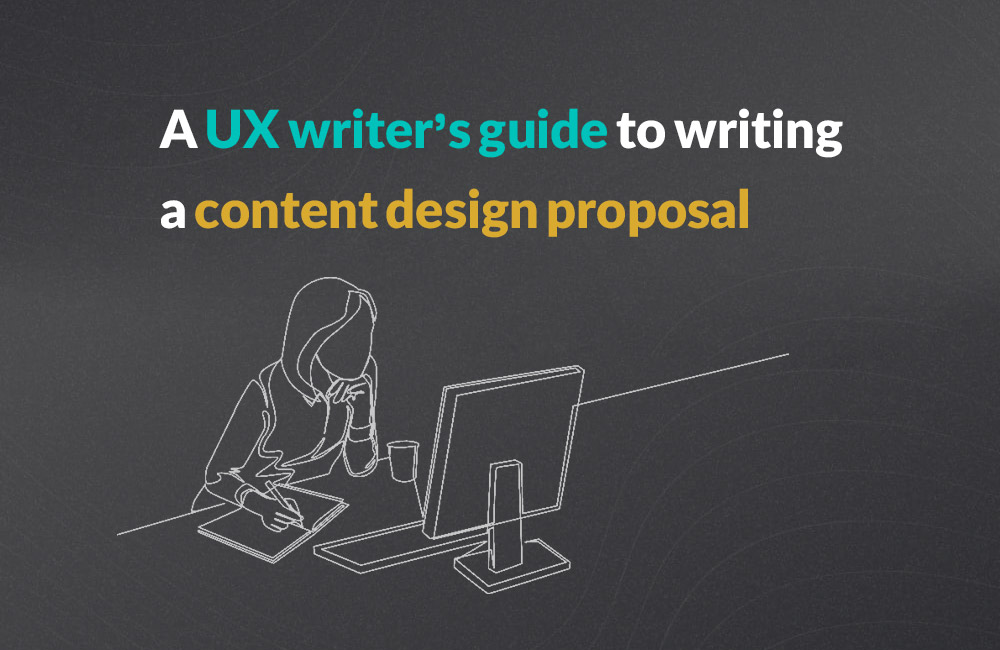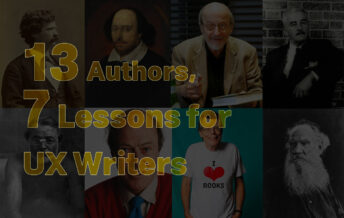A UX writer’s guide to writing a content design proposal

These days, you might be interested in accepting or ordering a UX content design project. In the field of UX content design, there is still a lack of awareness about how to work, the steps, and the proper conditions. Here’s what I’ve tried to explain about the why of each detail in a user experience content design proposal.
- What’s the point of the UX writing proposal?
- UX writing proposal: Steps to take
- The first part: the method
- Product identity
- Aligning on product limitations and requirements
- Visual details and product style coordination
- Setting up the work process
- Contextualizing content
- Content mediums: what’s important?
- What’s the role of the UX writer in content territory design?
- Part II: Co-operation terms
- What impression can we leave? (final output)
- Things to mention in the contract
- Then
What’s the point of the UX writing proposal?
There’s still a lot of ambiguity and ignorance about how and when to work with UX Writers in the product design market. We can be on the same page and aligned about missions, work methods, working conditions, etc. with a UX writing proposal, which is the basis for setting up a contract.
We don’t know about occult stuff. We don’t understand each other’s concerns. Since each party (customer or UXwriter) has “correct expectations” based on their hidden mentalities and defines what “correct work” means, our work will get tangled very quickly if we rely on unexpressed mental thoughts. Co-operation often fails, expectations are not met, and there is a lack of faith in cooperation.
We need to clarify what we are, what we can do, and what we need. UX content design proposals should be presented to clients for this reason.
UX writing proposal: Steps to take
Each product has its own details. Each product might have a different UX writing stage or have a different design system. User experience content design proposals should take the unique features of each brand or product into account.
The first part: the method
Product review
Be sure you agree on the point of view before you start.
Documentation is the key to content design, visual design, and user experience design.
Finding the points where coordination is needed starts with these questions:
- When do we start working together?
- wireframe
- Before finalizing the UID
- After the UID is finalized
- Before technical development
- During technical development
- After the product’s technical development
- Values, benefits, and features of the product
- Documentation related to user issues
- Usability test results
- Results of interviews or surveys
- Feedback from users to the support team or design team
- What’s new, why we’re redesigning
- Why did you redesign the product?
- Was it supposed to solve any problems?
- What were the pain points and how did you fix them?
Contact and coordinate with stakeholders in different business, technical, and product design sectors, to better understand the product, goals, tone, limitations, and requirements.
Product identity
We can be the correct language of the product if we know its identity. A user experience is like a conversation, and the conversation represents personality, characteristics, way of thinking, way of treating, and way of feeling.
Here’s what we need:
- Brand identity document
- Brand tone document
- Document or source of editorial and writing style
- User personas
Aligning on product limitations and requirements
Depending on the activity, persona, laws, etc., each product has different requirements.
Understanding the requirements and limitations:
- Technical
- Legal
- Marketing
- Verbal
For accurate and efficient design, it’s essential.
Visual details and product style coordination
- UX design tools
- Font
- Design system (content style section).
Setting up the work process
Preparing for the first meeting to learn about the product’s functions and missions.
Scheduling and planning review and feedback sessions after the “content design”.
Contextualizing content
Content design (UX Writing) isn’t just about creating user experience texts. In order to design powerful and effective words, the content designer needs to provide a suitable content base. As a result, three prerequisites are needed:
Expertise in content design principles
User experience laws
Adapting the content medium (UX Flow) and optimizing it.
Content mediums: what’s important?
Making the content easier to understand and read
Giving words power (using words correctly and appropriately so that each concept has the right weight)
Developing a concept expression strategy (How do we say it? Where do we say it? What concept should we use? Who should we tell and who shouldn’t? What’s appropriate and what’s inappropriate? What’s the user’s reaction and what can we do? And…)
Getting rid of ambiguous and complex patterns and processes that makes us talk and explain more.
What’s the role of the UX writer in content territory design?
Content designers should work with the design team to establish the right context for content. This is why the content designer needs to be involved from the start.
“Writing is Designing” explains the importance of designing the content territory well:
How should those words be written? Most people have this question in their minds, but it’s a tough place to start. Before you start writing, think about designing the experience you want your users to have. Here’s how we think about these two activities:
Writing is about fitting words together.
Designing is about solving problems for your users.
To find the right words, writing and design need to team up in your brain and work together.
Think about the two people talking about the Save button in their mobile app at the beginning of the chapter. How should they know what to write?
• A writing mindset asks: How many words will fit here? How should I describe this action? What terms are we using elsewhere?
• A design mindset asks: What terms are our users familiar with? What happens next? What problem are we really trying to solve?
You can’t have one without the other-and you need them both.
If the people you’re working with don’t understand that writing is designing, they’ll be surprised when you suggest that changing how the experience works is the best way to improve it. Some problems can’t be solved by writing, and learning to recognize when that situation occurs is just as important as learning to write a good button label.
Designing with words requires a broad range of skills, including many that don’t involve arranging letters into sentences. Framing your work this way will make you more effective.
Writing is Designing
After the building is finished, deciding about light and lighting is pointless. The main map is where it all starts.
Since words are the first thing a user sees, the content designer helps the design team:
- The content Territory (UX Flow) should be designed from the ground up as a foundation, not as a buttress to prevent the wall from collapsing.
- Design optimal routes that fit your concepts.
- Minimize user action failures.
- Make sure you use content properly, not as a band-aid.
- Make sure you’re always one step ahead when designing new features. (Awareness of the content’s context and expression leads to the next step.)
Part II: Co-operation terms
Here are some tips for reviewing and starting:
We have product reviews (before work starts) and review and feedback sessions to make sure we’re on the same page.
Our work base is more solid and our path is clearer with documentation.
Requirements
- User personas.
- The tone of voice document (brand identity document).
- The brand’s writing style guide.
- Product manager familiarization meetings
- Access to the design tools for editing.
- Interaction during the project (agile in doing work and receiving feedback, reviewing and finalizing each part).
- Reports on pain points, user feedback, and survey results.
What impression can we leave? (final output)
Our work will be felt from day one in several ways:
Create UX content, focusing on the main components, according to UXD principles and Product Design Style.
Suggestions for improving the user experience (focusing on design ideas) for more effectiveness. (We think UX writers are designers who try to make words stronger and remove unnecessary words and sentences and optimize the flow and design so they’re more comprehensible. We’ll make suggestions based on this, and we might be able to smooth the user’s path in some places by just modifying the flow.)
Creating the “after content design” version of project frames and pages.
Suggestions for usability tests or A/B/C tests…
Design guidelines for user experience content (based on product design system).
Things to mention in the contract
Focus on core components when designing content
Work on emergency flows simultaneously (at the client’s request)
Work on frames one by one (final review based on content guidelines)
As the project progresses, we adhere to revisions and corrections based on documentation, until we reach the best result.
The deadline for completing the project is (……..) a working day, but it can be extended with both parties consent. This deadline depends on stakeholders cooperating in providing documentation and the content designer delivering detailed work tasks.
The content designer should get real content for each section. Frames delivered with Lorem Ipsum text are incomplete and aren’t considered the basis.
The work process and legal and financial agreements won’t change if the project is done faster.
This project’s salary is (..).
It’s possible to specify the working days in the week and specific access times at the client’s request.
Our work is based on the current Figma file. We won’t include frames and components added during the project and after the contract is signed.
It’s the client’s natural right to draw up an NDA contract. According to its principles, the project manager won’t share the client’s strategic secrets with competitors or other companies.
Then
Here’s an example of content design agreement clauses you can customize.
Clarifying the contract clauses prevents disputes.
Remember: we’re done when the product’s ready. Our competence will be proven by giving a commitment and guarantee.
Feel free to add your comments to the UX Writing proposal if you think something was missed.


